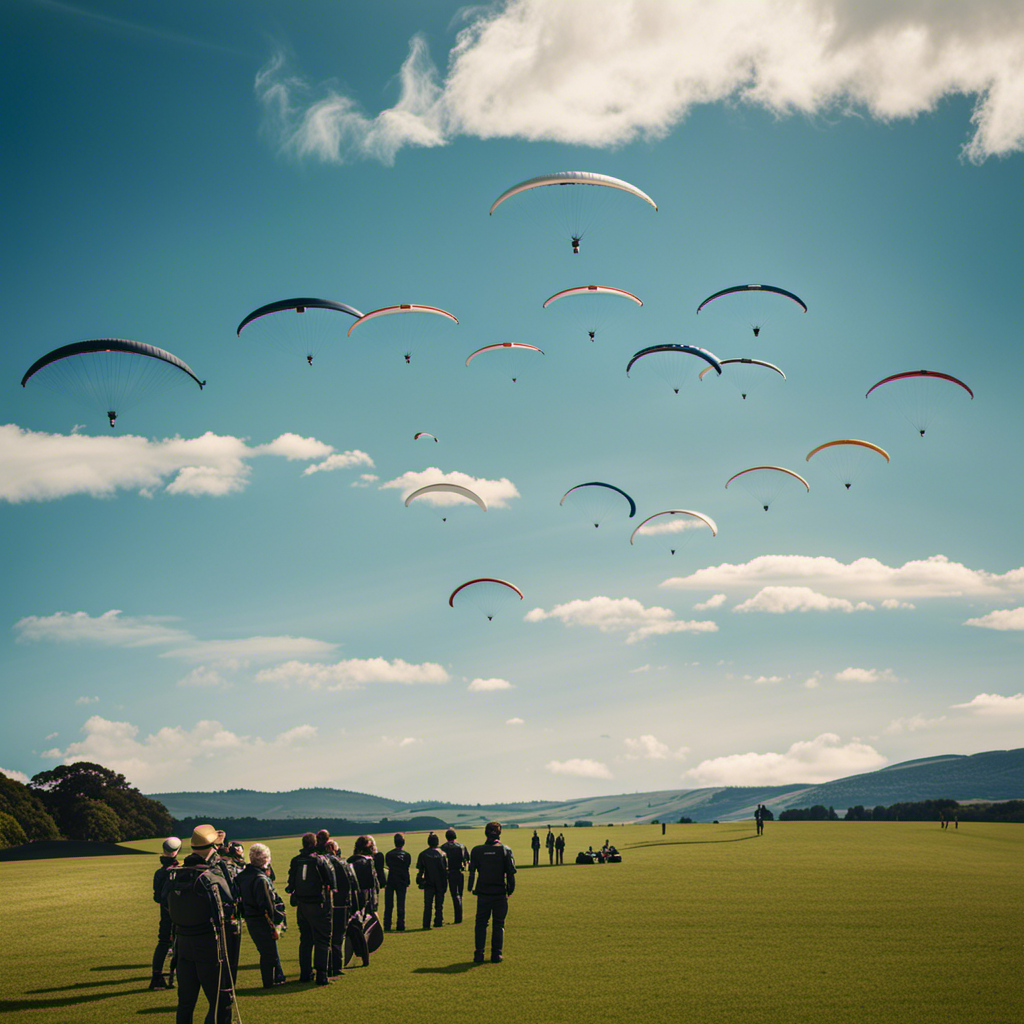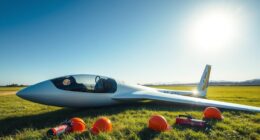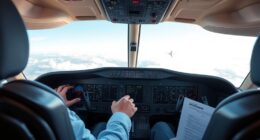I have always fantasized about flying up in the sky, gliding through the clouds, and feeling the liberation of being airborne.
But when can I officially call myself a pilot?
In this article, we’ll embark on a journey through the necessary steps to obtain that coveted first license.
From that exhilarating first flight lesson to logging flight hours and completing solo flights, we’ll explore the milestones that lead to proudly declaring, ‘I am a pilot!’
So buckle up and prepare for takeoff!
Key Takeaways
- Obtaining a pilot license signifies competence and achievement, allowing individuals to officially call themselves pilots.
- Gaining flight time and building a strong pilot resume is crucial for career advancement and showcasing dedication to safety and professionalism.
- Acquiring instrument and commercial ratings expands a pilot’s skill set, enabling them to fly in limited visibility conditions and explore various career opportunities in aviation.
- Reaching career milestones and continuously expanding knowledge and skill set helps pilots advance in their aviation careers and opens up new opportunities for success.
The Journey Begins: Taking Your First Flight Lesson
Now, it’s time for you to take your first flight lesson and officially begin your journey to becoming a pilot.
Taking flight for the first time can be both exhilarating and nerve-wracking. As you step into the cockpit, you may feel a mix of excitement and apprehension. But don’t worry, conquering fears is an essential part of this process.
Your flight instructor will guide you through the basics of aircraft controls, communication procedures, and pre-flight checks. You’ll learn how to take off, maintain altitude, and safely land the aircraft. This hands-on experience will help you build confidence and lay a solid foundation for your future flights.
As you gain experience in the air, you’ll soon realize that the sky is your playground.
Now, let’s transition into the subsequent section about being grounded in knowledge: passing your written exams.
Grounded in Knowledge: Passing Your Written Exams
To become a pilot, you’ll need to pass your written exams to demonstrate your knowledge. These exams are an important step in the process of obtaining your pilot’s license.
The passing requirements for these exams vary depending on the type of license you are pursuing. For example, if you are working towards a private pilot license, you will need to pass the Private Pilot Knowledge Test. This test covers a wide range of topics, including aerodynamics, weather, navigation, and regulations.
To prepare for these exams, there are various study resources available, such as textbooks, online courses, and practice tests. It is important to dedicate time and effort to studying, as a strong understanding of the material is crucial for success.
Once you have passed your written exams, you will be one step closer to soaring to new heights: logging flight hours.
Soaring to New Heights: Logging Flight Hours
Once you’ve passed your written exams, it’s time to start logging flight hours. This is where the real excitement begins, as you take to the skies and start gaining invaluable experience.
Here are four key aspects to consider when logging your flight hours:
-
Tracking progress: Using flight logbooks effectively allows you to keep a detailed record of each flight, including the date, aircraft type, and duration. This helps you keep track of your progress and ensures you meet the required flight time for your pilot’s license.
-
The significance of flight experience: Building confidence and skills comes from logging hours in various weather conditions, practicing takeoffs and landings, and navigating different airspace. Each flight adds to your knowledge and expertise as a pilot.
-
Learning from mentors: Flying with experienced instructors or mentors not only enhances your safety but also provides valuable insights and guidance. Take advantage of their expertise and learn from their years of experience.
-
Reflecting on each flight: After each flight, take the time to reflect on what went well, what challenges you faced, and how you can improve. This self-reflection is crucial for continuous growth and development as a pilot.
Mastering the Skies: Completing Your Solo Flight
Completing your solo flight is an exhilarating milestone in your journey to becoming a pilot. It is the moment when you take the controls of the aircraft for the first time without an instructor by your side. This experience is both challenging and rewarding, as it requires you to overcome fear and build confidence in your abilities. The table below highlights some of the challenges faced during solo flight and the strategies to conquer them:
| Solo Flight Challenges | Strategies to Overcome |
|---|---|
| Fear of Flying Alone | Visualize success and remind yourself of your training |
| Decision-Making | Follow standard operating procedures and trust your judgement |
| Radio Communication | Practice communication with air traffic control and fellow pilots |
Celebrating your first solo flight is a momentous occasion. It is a time to share memorable experiences with fellow pilots, exchange stories, and revel in the accomplishment. This camaraderie strengthens the bond within the aviation community and motivates aspiring pilots to continue their journey. As you navigate the airspace and work towards obtaining your private pilot license, you will face new challenges and opportunities for growth. Transitioning into the next section, let’s explore the process of obtaining your private pilot license and the requirements to officially call yourself a pilot.
Navigating the Airspace: Obtaining Your Private Pilot License
Navigating the airspace and obtaining your private pilot license is a challenging yet rewarding process.
To officially become a pilot, there are a few important steps to take. First, you’ll need to obtain a medical certificate from an aviation medical examiner. This ensures that you meet the physical requirements necessary to fly.
Additionally, understanding airspace regulations is crucial. You’ll need to study and pass a written exam that covers topics such as airspace classifications, communication procedures, and navigation rules.
Once you’ve completed these requirements, you can move on to the practical aspect of flying, which includes logging flight hours, passing a flight test, and demonstrating your knowledge of various flight maneuvers.
With your private pilot license in hand, you can now expand your horizons by pursuing advanced ratings and certificates, allowing you to fly in more complex airspace and operate different types of aircraft.
It’s an exciting journey that never stops challenging you to grow as a pilot.
Expanding Your Horizons: Pursuing Advanced Ratings and Certificates
After obtaining my Private Pilot License and gaining confidence in navigating the airspace, I was eager to expand my horizons and further enhance my skillset. Pursuing advanced ratings and certifications was the logical next step in my journey as a pilot. These additional qualifications would not only increase my knowledge and proficiency but also open up new opportunities and challenges.
One way to pursue advanced certifications is by obtaining an Instrument Rating (IR), which allows pilots to fly in low-visibility conditions using only instruments. Another option is to pursue a Commercial Pilot License (CPL), which enables pilots to fly for hire or reward. Additionally, there are specialized ratings such as Multi-Engine (ME) and Flight Instructor (FI) that provide further expertise and teaching capabilities.
Safety First: Understanding the Importance of Continuing Education and Training
To ensure the safety of yourself and others in the aviation industry, it’s crucial that you prioritize continuing education and training. As a pilot, staying up to date and continuously learning is of utmost importance. Here are a few reasons why:
-
Safety: The aviation industry is constantly evolving, and new technologies, regulations, and procedures are introduced regularly. By staying informed and trained, you can enhance your safety practices and reduce the risk of accidents.
-
Professional Development: Continuous learning allows you to improve your skills, knowledge, and expertise, making you a more competent and effective pilot. It also shows your commitment to your profession and can open up new opportunities for career advancement.
Building Experience: Gaining Flight Time and Building a Pilot Resume
Once you have obtained your pilot’s license, it’s essential to focus on gaining flight time and building a strong pilot resume to further your career in aviation.
Gaining experience is crucial in the aviation industry, as it not only enhances your skills but also demonstrates your commitment to safety and professionalism. To meet flight requirements, I actively sought opportunities to fly and logged hours in various aircraft types, including single-engine and multi-engine planes.
I also took advantage of volunteering for aerial survey missions, which allowed me to gain experience in different flying conditions and environments. By consistently building flight time and documenting my accomplishments, my pilot resume showcases my dedication and expertise.
As I continue to reach new milestones, such as obtaining instrument and commercial ratings, I am excited to expand my knowledge and skill set in aviation.
Reaching New Milestones: Obtaining Instrument and Commercial Ratings
As you work towards obtaining your instrument and commercial ratings, you’ll be able to expand your skill set and open up new opportunities in the aviation industry. These ratings are important milestones in your journey to becoming a well-rounded pilot.
The instrument rating allows you to fly in weather conditions where visibility may be limited, relying solely on instruments to navigate. This skill is highly valued by airlines and charter companies.
The commercial rating, on the other hand, allows you to fly for compensation or hire. With this rating, you can explore career opportunities such as becoming a flight instructor, flying for a regional airline, or even starting your own aviation business.
Obtaining these ratings not only enhances your flying abilities but also positions you for a successful and fulfilling career in aviation. And with each new rating, you take another step towards proudly declaring, ‘I am a pilot!’
Proudly Declaring: "I Am a Pilot!
Reaching the milestone of obtaining your instrument and commercial ratings allows you to proudly declare, ‘I’m a pilot!’ It is a moment of great satisfaction and a sense of achievement.
After countless hours of study, training, and hard work, you have acquired the knowledge and skills necessary to safely operate an aircraft in various conditions and for commercial purposes. This accomplishment not only signifies your competence as a pilot, but also opens up new opportunities for your aviation career.
With your instrument rating, you can confidently navigate through challenging weather conditions using advanced navigational aids. And with your commercial rating, you can now fly for compensation or hire, taking your passion for aviation to the next level.
Frequently Asked Questions
What are the requirements for obtaining an instrument rating?
To obtain an instrument rating, I must meet certain requirements. These include completing a minimum number of flight hours, passing a knowledge exam, and demonstrating proficiency in instrument flying. Proper exam preparation is vital to success.
How many flight hours are needed to obtain a commercial pilot license?
To obtain a commercial pilot license, I must accumulate a minimum of 250 flight hours. This can be done by building flight experience through various pilot training programs available in the industry.
Can you explain the process of obtaining advanced ratings and certificates?
To obtain advanced ratings and certificates, pilots must complete additional training beyond their initial pilot certification. This process involves gaining experience, meeting specific requirements, and passing practical exams to demonstrate proficiency in various areas of aviation.
What options are available for continuing education and training for pilots?
Continuing education for pilots offers a wide range of opportunities for growth and advancement. Flight training programs, workshops, and seminars provide valuable knowledge and skills to enhance our abilities as pilots.
How can pilots build their flight time and create a strong pilot resume?
To build flight time and create a strong pilot resume, I recommend taking on various flying opportunities, such as flight instructing, aerial surveying, or skydiving operations. Additionally, joining aviation organizations and participating in volunteer activities can enhance your resume.
Conclusion
In conclusion, obtaining your pilot’s license is an exciting and rewarding journey that requires dedication, knowledge, and experience.
While some may argue that becoming a pilot is a difficult and expensive endeavor, the sense of accomplishment and freedom that comes with flying is truly unparalleled.
Despite the challenges, with the right training and commitment, anyone can achieve their dream of becoming a pilot.
So don’t let any obstacles hold you back, take to the skies and proudly declare, ‘I am a pilot!’
Orion, better known as “Jetstream,” is the voice that brings the stories of the skies to life. His fascination with aviation began at a young age, sparked by his father’s tales of flying and adventure. Orion’s journey into the world of gliding was serendipitous, and from the moment he took his first glider flight, he knew he had found his calling.










